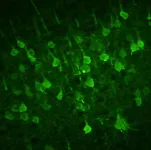(Press-News.org)
Niigata, Japan – our movements are controlled by multiple neural pathways that connect the brain and spinal cord. In particular, neurons in the cerebral cortex send commands to the motor neurons in the spinal cord and then to the muscles, thus eliciting the required movement. However, this flow of neural information is compromised in amyotrophic lateral sclerosis (ALS)—a widespread progressive neurodegenerative disease in which the muscles gradually atrophy, making movement and breathing difficult. Moreover, a protein called TDP-43 has been found to abnormally accumulate in the neurons affected by ALS, leading to the degeneration of these neurons and motor dysfunction.
In patients with ALS, the motor dysfunction symptoms usually appear in one part of the body, such as the limbs, and then progress to others. This further suggests that degeneration starts in one type of motor neuron and, thereafter, propagates to other motor-related neurons. Previous studies have highlighted the accumulation of TDP-43 in motor neurons as a co-occurrence with ALS. Given these seemingly disparate but related findings, researchers from the Brain Research Institute at Niigata University couldn’t help but ask: could TDP-43 be responsible for propagating degeneration in ALS?
To address this question, the researchers developed ALS mouse models that primarily accumulate TDP-43 in the cortical motor neurons, spinal motor neurons, or skeletal muscles. They then examined how the TDP-43 in specific motor neurons initiates disease progression to other motor-related neurons. Their study was published in Acta Neuropathologica on Aug 9, 2023.
“TDP-43 accumulation is seen in most of the patients with ALS, but there has been a long-standing debate on whether it propagates through the motor pathway and causes disease progression,” says senior author Dr. Osamu Onodera, professor at the Department of Neurology, Brain Research Institute at Niigata University.
The researchers found that TDP-43 induced in the cortical neurons of the mouse ALS models caused mild degeneration. They further found that TDP-43 was transported along the axons and transferred to the oligodendrocytes—non-neuronal cells that support neurons by enwrapping axons with a protective layer called myelin to facilitate neuronal signal transmission.
In contrast, TDP-43 induced in the spinal motor neurons did not spread to other cortical or spinal neurons but broadly induced cell death in the motor neurons and other neighboring neurons in the spinal cord. In addition, it led to severe atrophy of the muscles, which further led to motor dysfunction.
Regarding their findings, co-senior author Dr. Masaki Ueno, a professor in the same institute, says, “Our findings suggest that pathogenic TDP-43 has multiple properties to propagate degeneration in the motor pathways in ALS, probably by spreading itself and inducing other toxic events such as degeneration and inflammation.”
Their data revealed that TDP-43 spreads across neuroglial connections in the motor pathway and causes different pathological events to degenerate the spinal cord, suggesting that TDP-43 has distinct mechanisms for degeneration in the motor circuits of ALS.
“Elucidating the mechanisms of TDP-43 spreading and other pathological events of propagation will lead to the development of a novel therapeutic approach to prevent disease progression in ALS,” concludes first author Dr. Shintaro Tsuboguchi, an assistant professor at the same institute. The findings of this study will pave the way for the effective treatment of ALS, offering hope to many patients with ALS worldwide.
The study “TDP-43 differentially propagates to induce antero- and retrograde degeneration in the corticospinal circuits in mouse focal ALS models” was co-authored by Shintaro Tsuboguchi, Yuka Nakamura, Tomohiko Ishihara, Taisuke Kato, Tokiharu Sato, Akihide Koyama, Hideki Mori, Yuka Koike, Osamu Onodera, Masaki Ueno, all at the Brain Research Institute, Niigata University in Japan.
The research was supported by the Japan Society for the Promotion of Science, Japan Agency for Medical Research and Development, Tsubaki Neurology grant, and Japan ALS Association.
END
A striking image of the invasive orange pore fungus (Favolaschia calocera), which highlights the potential threats the species may pose to Australian ecosystems, has won the third BMC Ecology and Evolution image competition. The competition showcases the wonder of the natural world — both past and present — and celebrates those working to understand it. The winning images are open access and freely available for use under a Creative Commons Attribution 4.0 (CCBY) license.
The overall winning image depicts bright ...
The end of the last Ice Age also marked the end for more than three dozen genera of large mammals in North America, from mammoths and mastodons to bison and saber-toothed cats. Details concerning the precise timing and circumstances, however, have remained murky ever since.
A team of scientists that included Texas A&M University archaeologist Dr. Michael Waters recently focused on the well-known Rancho La Brea Tar Pits in southern California in their quest to provide answers to these questions, resulting in the most exact and detailed timeline for the extinctions that happened during the latter part of the Pleistocene ...
In trials, the antipsychotic drug brexpiprazole (Rexulti) failed to provide a clinically meaningful benefit and increased the risk of death. Yet the US Food and Drug Administration (FDA) has fast tracked its approval, making Rexulti the first antipsychotic for treating agitation in elderly patients with dementia.
At a cost of around $1,400 a month Rexulti’s makers, Otsuka and Lundbeck, are forecasting an additional $1 billion in annual sales, but there are serious questions about the harm-benefit balance of this drug, writes investigative journalist Robert Whitaker in The BMJ today.
The decision may also reverse ...
The University of Arizona College of Nursing was one of 50 institutions nationwide to receive a Health Resources and Services Administration grant to increase the number and diversity of Doctor of Nursing Practice students in clinical rotations at Federally Qualified Health Center partners in southern Arizona.
The project will use the $2.6 million in funding from the HRSA’s Advanced Nursing Education Workforce Program to deploy immersive managed practice adaptable clinical training, or IMPACT, starting in the spring semester of 2024.
The grant will support students pursuing doctorates in the specialty areas ...
Spectacles that are marketed to filter out blue light probably make no difference to eye strain caused by computer use or to sleep quality, according to a review of 17 randomised controlled trials of the best available evidence so far.
Nor did the review find any evidence that blue-light filtering lenses protect against damage to the retina, the light-sensitive tissue at the back of the eye, as included studies did not evaluate this outcome. Blue-light filtering lenses, also known as blue-light blocking spectacles, have been increasingly prescribed or recommended, often by optometrists, ...
In 1956, theoretical physicist David Pines predicted that electrons in a solid can do something strange. While they normally have a mass and an electric charge, Pines asserted that they can combine to form a composite particle that is massless, neutral, and does not interact with light. He called this particle a “demon.” Since then, it has been speculated to play an important role in the behaviors of a wide variety of metals. Unfortunately, the same properties that make it interesting have allowed it to elude detection since its prediction.
Now, a team of researchers led by Peter Abbamonte, a professor of physics at the University of Illinois Urbana-Champaign, ...
Most of us who’ve reached middle age have noticed a slowing in memory and cognition, but scientists don’t have a clear picture of the molecular changes that take place in the brain to cause it.
Now, a study in mice has determined that the most pronounced changes occur in the white matter, a type of nervous system tissue that’s integral to transmitting signals across the brain. The study also examined two treatments — caloric restriction and infusions of plasma from young mice — that affect certain regions of the brain, with ...
In an experiment on how turbulent boundary layers respond to acceleration in the flow around them, aerospace engineers at the University of Illinois Urbana-Champaign observed an unexpected internal boundary layer.
“Not only were we able to identify a new internal boundary layer, but we were able to systematically track its height so we can understand its growth rate. We also noticed that it only formed if our pressure grading, our acceleration, was sufficiently strong. There was a threshold under which we didn't ...
New research to be presented at this year’s Annual Meeting of the European Association for the Study of Diabetes (EASD) in Hamburg, Germany (2-6 October) shows that among people with type 1 and type 2 diabetes, being divorced is associated with a two-thirds higher risk of lower limb amputation (LLA) (amputations below the knee level) compared with being married, and being male is associated with a 57% higher risk of LLA compared with being female. The study is by Dr Stefan Jansson, Örebro University, Örebro, Sweden, and colleagues.
Deterioration in the structure of both large and ...
DURHAM, N.H. — Pregnant women that live in walkable communities—with more sidewalks, parks and walking paths—not only engage in more physical activity but are also more likely to experience favorable birth outcomes, according to research from the University of New Hampshire.
The study, published in the journal of Economics and Human Biology, found that expectant mothers living in walkable counties tend to engage in more walking and exercise and have fewer issues with premature births, low birth weight, gestational diabetes and hypertension. Walking is often recommended as a safer, ...



